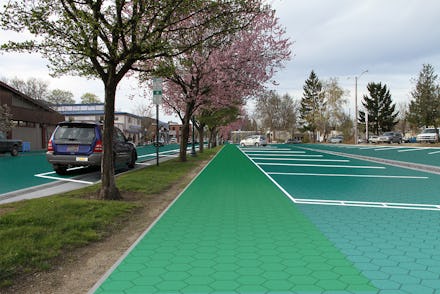The Crazy Plan to Revolutionize America's Roads Just Took a Step Forward

The news: We now have globally connected phones, robots that move and talk and cars that drive themselves. So isn't it about time our roadways got a facelift too?
Solar roadways, created by Scott and Julie Brushaw, may be the answer to America's out-of-date pavement. The Brushaws launched a viral Indiegogo campaign to revamp our roads by replacing the nation's asphalt with glass hexagons embedded with solar panels. The panels are capable of generating 14 trillion kilowatt hours of electricity per year, more than three times what the nation uses each year. And with five days to go until the campaign ends, the Brushaws have surpassed their funding goal and raised more than $1.3 million thus far.
Put simply, America's current infrastructure sucks. Our roads, bridges, public health systems and mass transit all lag behind the most developed countries in the world. The 2013 Report Card for America's Infrastructure reported insufficient investments in the road sector; this has led to dangerous conditions and declining performance. The Federal Highway Administration has estimated that they would need $170 billion annually to "significantly improve conditions and performance."
An innovative approach, like the Brushaws', is an enticing alternative to mere upkeep. Solar roadways would do double duty by making America's roads better and supplying the country with renewable energy.
Image Credit: Sam Cornett
Planes, trains and automobiles. Back in 2011, President Obama said, "America used to have the best stuff — best roads, best airports, best seaports. We're slipping behind."
In the World Economic Forum's ranking of national infrastructure systems, the United States is failing to even rank in the top five. In the 2007–08 report, the U.S. fell to sixth place. By the 2011–12 report, the U.S. was in the 16th position, on par with Malaysia. (Hong Kong topped the list that year.)
While solar roadways may not come to pass everywhere, at least there is an effort to upgrade an out-of-date system. The Netherlands recently implemented a 500-meter stretch of highway with light-absorbing glow-in-the-dark paint as an alternative to expensive street lighting. In spite of the many challenges the Tron-like plan may face, it is an innovative technology that has a lot of potential.
Adopt this road. Solar roadways are not a foolproof plan as of yet. It remains unclear how the Indiegogo campaign money will be used, and the company itself still has many hurdles to clear before solar paneled roads become the norm. Still, the U.S. Department of Transportation thought enough of the Brushaws' company to give a grant for building a rudimentary prototype of the glass.
In spite of its challenges (it could cost $56 trillion to actually convert roads to solar roadways), the idea is promising. If nothing else, the campaign will hopefully inspire Americans to consider a crucial area of our national livelihood, and realize that our infrastructure needs as much of a tech upgrade as our iPhones.